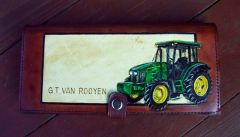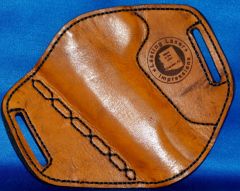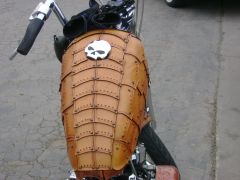-
Posts
122 -
Joined
-
Last visited
Content Type
Profiles
Forums
Events
Blogs
Gallery
Everything posted by Skald
-
Ah, I am looking at hidecrafter.com right now, but I have a problem to guess which beveler in particular you have been using. I really like that sharp/thin beveling line. I got that B-893 tool too, I'll make sure to try that effect out, doesn't look like it's been worked much, still the lines are pretty clear. Good work.
-

John Deere tractor chequebook cover :-)
Skald commented on Anet du Toit's gallery image in Our Leatherwork Galleries
-
What did you use for beveling? Not some stamping tool it seems, I never get such fine deep lines with them. When I use a "folding bone" (I guess that it what it's called over there), I get something similar, but it's for marking stitching lines when I am wet shaping things. And about the stem of the leaf, those really fine shallow lines, is that the "hair knife" thing, or am I totally whack here? Really nice work anyway, truly.
-
Till "svennarna" här: Jag håller på att fixa till en liten klädkammare här att hålla till i. Skall fixa till ett ganska så massivt och tungt träbord så att det passar där, och klä golvet med sådan gummimatta som brukar användas i industrilokaler. Kanske kan koll in på en stenfirma i mina föräldrars del av stan (vet inte om de gör specifikt gravstenar där, men jag gissar på det), och se om de har någon bra bit jag kan få billigt, annars får jag helt enkelt beställa en granitplatta. "Poundomat" eller liknande matta skall fixas också. Skulle det visa sig att det fortfarande låter som om jag försöker riva lägenheten, så får jag prova "sandsäckstricket" också hehe... Kan tänkta mig att det är effektivt, men av någon anledning går jag inte direkt igång på tanken att ha en sandsäck hemma om det inte behövs. And now some for all: I've tried tooling a little in my lap, but I feel that a lot of precision and vision gets lost for me that way. I've also suffered quite severe damages to both my neck and lower back when I was younger, doing stupid things with mountainbike and snowboard, so I better not push my lock all too much and sit bent like a cheese doodle for hours. I have managed to "gym away" most neck and back problems, but I have to be quite careful with working positions and such.
-
Part of the problem solved, today I got myself a very fine maul by the mail, sent to me by the dear gentleman busted. Once again I am overwhelmed bu the kindness and supportive attitude here, if there were just a few more of you around in the society, the world would be a far better place. I am soon turning the "walthru closet" into a miniature workshop, and I'll order such a rubber mat and a granite slab next week. So, thank you all, especially Mr. Busted.
-
Seems my worries ain't much to worry about then. I'll get myself some suitable stamps for modification then. As soon as I feel I can afford it, I'll start getting some proper quality stamps as well, thanks for all the suggestions on where to get hold of them.
-
I started to suspect that people must have modified tools in their "toolbox". What I am a bit worried about are those modern semi-junk stamps, like most of the ones I have, that are probably casted in some junk metal, and then drenched in chrome. I fear that the chrome will sort of "flake off" and cause trouble (nice with flakes of metal flashing in your leather), and maybe the metal itself would cause the leather to go black or whatever. I noticed that nailing the leather to a board (wet forming) made the holes black, but that was a several hours contact with the leather, so it might be a bit different.
-
When carving figures and stamping them accordingly, I often come across a problem, namely that my background tools (and others) are simply too big. Sometimes I can of course tilt the stamping tool a little, and make partial impressions to cover the specific area, but at times even this isn't possible. I tend to work with quite small projects, and in addition quite detailed patterns, so I really would need a little smaller tools to work with. My plan is to buy "dupilcates" of the tools in question, and simply grind them down to a more suitable size. It wouldn't be a very high cost, and not very difficult either. What I wonder about is if the loss of chrome on parts of on the tools would cause any problems? Have anyone tried this? Or are there actually some of these small stamps available for purchase already? I have mostly Tandy's stamps, and I do have the smallest ones I think they have, but they simply ain't small enough for me.
-

1911 and 2nd amendment holster 11.jpg
Skald commented on LastingLaserImpressions's gallery image in Our Leatherwork Galleries
-
I've done quite a lot of casting in pewter, brass and silver. The casting itself isn't really rocket science, it's the mould making part that's difficult. For pewter, there are these RTV silicone compunds that you can buy, which are highly recommended. You don't need any particular equipment to get that going, piece of cake - if you just sniff up some basic tutorials to get going. You can of course also make sand castings, but that's a bit more tricky, depending on what you are about to make. Sand castings can't take "negative angles" (naturally), if you do, you'll ruin the mould as you try to remove your model. The detail level isn't really good either, and another downside is that you have to make the mould anew for each casting. The positive aspect is that you can cast almost anything in sand form, an RTV silicone mould can't take much heat, even low melting point metals like pewter will ruin it in the extent. You can probably make a good mould out of limestone too, but that's more or less an artform in itself. Those are the realistic small scale/beginner alternatives. Then there are of course alternatives like plaster moulds, where you use the "lost wax" method (i.e. mould a wax model into the plaster, burn the wax out of it - pour in silver or whatever, and crack the mould open, and there you are). There are also these kinds of rubber compounds, that require pressure and heat (equals expensive equipment). Metals like silver will require either a centrifugal sling or vacuum cabinet (those ain't for free either), otherwise like 9 out of 10 castings will look like sh*t. So anyway, making buckles in pewter and/or brass isn't a big problem, but making a proper mold is more of a problem. For example making the loop for the belt strap in one piece with the buckle to start with, isn't all that easy. You'll have to think "tree dimensional" right from start, otherwise you'll suddenly find out that it must be done in another way, over and over again until you get it right. Such projects are perfect to elaborate over in your bed, when you can't go to sleep.
-
Oki, lots of good suggestions! I guess I'll turn a closet here (a "walkthru" kind of closet) into a miniature workshop quite soon. And as I work with silver too, getting a tree stump wouldn't be a bad idea at all (need to use a small anvil at times). I'll get myself a granite or marble slab + rubber mat too, next time I make an order for stuff, plus a leather mallet or something like that. Hopefully it will fix the piece of cake. Been thinking quite a lot about how to come to terms with this, and it seems when asking you I was quite right. BIGGUNDOCTOR: The man at the picture is an aghori from India, a certain kind of "yogi master", following a tradition which has striking similarities with Scandinavian shamans etc. Apart from me finding the tradition very interesting, he looks rather amazing, and I fell in love with it (the picture, that is) at first sight. However, I hope people doesn't think that it is me on the picture, I have a little more well trimmed beard and hair. Edit: There are sadly enough no recreation room of that sort here, only a kind of "kitchen" which you can use for cooking with friends and have dinner etc. Mostly ol'timers that use it. I guess my activities are not seen as proper for that particular place. I lived in another area in Gothenburg earlier, where there was a sort of workshop (with no tools, only workbench etc.), but here there is none. I am looking out for an opportunity to rent a small garage or similar from the "landlord", but there are non vacant right now.
-
I don't have a very exclusive or expensive range of tools, yet. So I simply work on the kitchen table, with a cutting mat on it. I don't have a leather mallet or such either, I just have a wooden one. So, pounding these stamps makes quite a lot of noise. Not that I myself get disturbed by it, but I have a half a year old son, who doesn't like it at all, especially not when he's going to sleep. My fiance doesn't mind all too much, she can simply stay in another room. But it's not so simple that I can do this when she's out with him for some hour, a neighbor have just complained about it too. We live in this old block of flats, where you can hear noise from neighbors pretty easy - sadly enough (trust me, I don't like to hear them either...). I do have my parents place, that I can go to if I really need to, but it's like a 40 minutes travel to get there, so it's a several hours project to go there and work a little, and then head back. It costs money too going there, of course. SO... What "tricks" do you have to give me? If there are any. I guess such a marble/granite slab and that kind of rubber mat beneath it, and getting a leather mallet would help a little? I also thought about getting a suitable large tree stump indoors and use for table. As it's massive, it should really absorb much of the vibration/noise etc., and keep the sound level to a minimum. Or am I all wrong? I really can't afford to hire a place to use at workshop right now, but I might in the future (as I have a lot of other projects going on or starting up, and will need such a space sooner or later), I don't have the money to get a house on our own either. Renting an apartment is the only option right now, sadly enough. So finding another place (besides going to my parents, and use my fathers "multi purpose workshop" that is). I really want to start working more with this stuff, but as it is now, less or hardly at all is my only option.
-
I think it's pretty much "dead". I would try to get some small bits of it removed, and try some different conditioners etc., and see what does most good, if any of them do. I found some old gloves (and I mean OLD, like +100 years) that I tried to restore. I used a type of oil that's around here called "Ekol olja", most often used for horse gear. It did some good, but not so much that they were good for any use. Speaking of old leather, I found a batch of leather that was 80-90 years old, that had been used in my grandfather's uncle's leather workshop. It was still in almost perfect condition. The color had turned a little mustard/greenisch, and there were some stains of mold at it. But the most part of it was possible to use. I have used it for some projects, after dyeing it. It works perfectly well. So I guess it's much a matter of how the leather was produced, and how it has been kept through the years.
-
-
I suspected "blobs & sputters", and I guess I won't even bother to try that then. There are no Harbor Freight over here, but there are some similar companies, and I have looked up a "budget kit" I'll get hold of soon. Guess it's better to spend a little more right off, instead of being forced to do so anyway after the cheapest possible solution fails.
-
Would something like this work you think http://www.cchobby.se/pump-sprayflaska-1-st.aspx It's not a bottle where you have to pump like a maniac while spraying, you sort of pump up the pressure beforehand, and then just spray until the pressure is out. There were some hair spray bottles in the 80'ies with this pump function, if someone remember.
-
Noticed that the URL threw you to the frontpage, anyway it's called "fettpenna" in Swedish. It costs 23:- and $1 is about 6-7:- Someone else might know if there's some possibility to get hold of one over there. I really like those pens, and recommend them to anyone doing a lot of cutting etc.
-
Here's an URL for one, in a Swedish webshop: http://www.tjaderlader.se/shop/prod.aspx?productid=559704&groupid=74599&sortafter=0&sortafterchild=0&refcode=f As you can see, it's just a ballpoint pen basically, but instead of ink, it's loaded with fat of some sort. It makes a "silvery" line, which is quite easy to rub off (it goes away defensively and completely with just a drop of deglazer). Still it sticks good enough for you to do your work without it smearing or rubbing off by accident. It's really quite a good thing for marking stitching and cuts/grooves and whatever you need to do. One could of course use a stylus tool instead, but I really like this kind of pen. For people with "number dyslexia" like me, who has to double check every kind of measurement I take, it's invaluable.
-
If you use a stitching groover, or simply mark the supposed stitching line with a "fat pen" (don't know what you call it over there, but it's simply a ballpoint pen loaded with fat), and then use a stitching wheel to mark the holes, you'll have a nice straight line of stitches, just like you want them. It's always easy to get it "not so straight" at the backside, but if you fix your work with a stitching pony, it's far easier to make the awl go through straight. I sometimes cheat with certain parts (that are difficult to put in the stitching pony), and place the work on a cutboard instead, and punch the holes with an awl while it's flat on the board, much easier and better than just holding it and doing it freehand. A stitching pony makes it much faster though, as you can hold both awl and needles at the same time, and as there's no need to pick up and put down the work between each stitch. Finally, it's a matter of experience, as everything else. After some meters of practice, you'll be both faster and more accurate.
-
There's usually some pebble backgrounders around on eBay, if eBay floats your boat. It's usually about $25, and "Buy it now!" and not auctions.
-
I am eager to get to know too. I fear BIGGUNDOCTOR is both right and wrong. I.e. many or most (all?) just do it the way he describes, but I think it's too much too ask to explain to anyone using it that "You have to use the bottom slot first" - and then the card goes mysteriously "gone" when using it in everyday tear and wear. You could of course put some small bits of leather at the backside, and glue it to both layers, at the point where you want the card to go no further. But that would quite surely be visible on the finished product after a while. Not nice.
-
I cut thinner leather in one cut, and use a metal ruler if possible (i.e. it it's a straight cut). I use an ordinary cardboard knife for a little shorter pieces, and this round/rolling blade for longer cuts - as I find it easier to make a long continuous cut with the rolling blade. The thicker leather is most often dealt with in two cuts, first I "mark" the cut and cut like half through, then I cut once more all the way through. I have noticed that I tend to cut wrong when I use "full force", which I need for thicker leather. Most often it goes well using this "two cuts" technique, the cut edge can be a little irregular, but 9 times out of 10, this doesn't matter as I slick the edges anyway. The part I often do wrong however is not the cut itself, but the measurement, either I simply calculate things wrong, or I happen to make it a millimeter or two wrong when I do my cutmarks. So for me, the measuring part is the most thrilling.
-
I am just glad to share some culture. I don't know the correct name for the type of knife really, I only know puukko means "knife" in Finnish, and just about there ends my Finnish skills end hahaha... The first knife is more or less traditional saami design, and the bottom part is reindeer horn. There are plenty of knives around with the lower part made of wood as well, most often the weirdo looking birch kind of wood (I don't know what you call it, but here it is "vril" or "knosor"), which is like marbled with different color shades - it actually looks like some really exclusive exotic type of wood. The second one is quite a large kind of knife (blade like +30 cm or something like that), with a sheath made of full leather (often though with a core of wood or plastic). I guess it's made of leather mainly because it's so large. It would be rather uncomfortable and noisy, and heavy to carry around such a large knife with a sheath of wood or horn. That sort of knife more or less replace the need for a small axe and saw, when out in the wilderness. I have seen some of these with sheath of horn as well, but most often they are made of wet molded raw hide. The leather stamping on them are most often rather simple, repetitive patterns.
-
My father is a quite good knife maker, he does both "full leather" and "semi leather" knife sheaths. He makes them out of raw hide, or whatever it's called over there, which makes knives stay perfectly in place, without the need of any sort of strap or whatever to keep it from falling out. There's a "snap" when you put the knife in place. Basically, he covers the knife handle with a sheet or two of paper, and wet molds it around the handle, and then stitch it up. For full leather sheaths, he makes some sort of bottom part of wood or plastic (to prevent the blade from cutting the sheath, and to stiffen it up a little), and then go with the same procedure and wet mold it and stitch it up. It's thanks to the type of leather that this kind of sheath works. And no - it's not sensitive to moist or dryness or anything I can come to think of. I have had one of his knives since I was 6, I am 33 today - and the knife and sheath works as well as the day I got it. Most traditional knives in Scandinavia are made this way, and it would really be nice to see it spread to other parts of the world as well, so make a try! Here are two examples of what I talk about: http://www.tarendodesign.se/kundbilder/TraHornslojd/th_l/Charlotte_Kallas_presenter_016.jpg http://www.tarendodesign.se/kundbilder/TraHornslojd/th_l/016.jpg He more or less mass produce these two specific kinds of knives, but he also makes quite a lot more exclusive knives as well.
-
Casey Jordan: The pattern is like 5 cm's wide., and the cut is like less than 1 cm I guess. Pete: It's deeper as deep as the other cuts, unfortunately. Thanks for all those suggestions. I'll experiment with the same set-up of cuts on some scrap bit, and see what works best for me.





